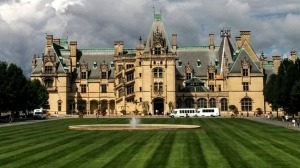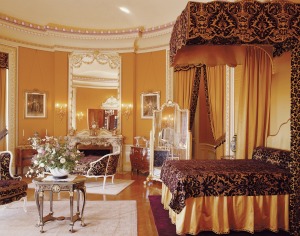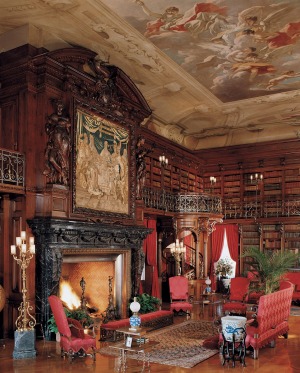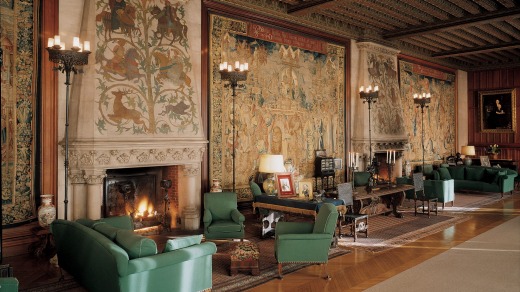
Perched at the edge of North Carolina's Blue Ridge Mountains is a grand castle looking all the world like a Loire Valley chateau, set amid 32 square kilometres of forest, manicured gardens and ornamental lakes.
Biltmore, the largest privately owned house in America, possibly the world, is the culmination of a young man's dream. A very rich and fortunate young man, it must be said, with a fair bit time on his hands for playing Lego with Indiana limestone and Italian marble thanks to his grandfather, Cornelius "the Commodore" Vanderbilt.
The Commodore, sometimes rather unkindly referred to as a "robber baron", amassed his great 19th century fortune from steamships and railroads.

I will build an opulent French renaissance chateau to rival Blois, Chenonceau and Chambord with a fair bit of English estate thrown in, young George Washington Vanderbilt II told himself in 1888.
I will fill it with paintings from the grand masters including Renoir, Whistler, Boldini and Albrecht Durer, 16th-century Flemish tapestries, Ming dynasty bowls, Meissen porcelain, Chippendale and Louis XV furniture, Napoleon's chess set, 18th-century Viennese ceiling paintings and a number of moose heads.
I will engage America's master architect, Richard Morris Hunt, as well as landscape architect Frederick Law Olmsted, designer of New York's Central Park. I will commission John Singer Sargent to paint portraits of my family and me to hang everywhere.

I will call it Biltmore from "Bildt" after the family's ancestral Dutch farming village and "more", from the old English word for "rolling uplands".
If people deride my fairytale retreat as a colossal white elephant and sneer at me for being a pushy upstart with a vulgar urge to build large edifices in my name, I will say to them: fiddlesticks!
And I will be right, because four generations on, my descendants are now running the place as a profitable, self-sustaining venture – a kind of Downton Abbey for paying stickybeaks that is an important tourist attraction for Asheville and North Carolina, employing 2000 people.

George Vanderbilt's great-grandson William "Bill" Cecil jnr ensures that the original home and contents are preserved as they once were. Family members even narrate the audio tour.
Vanderbilt fell in love with Asheville on a trip with his mother in 1888. The town was popular with the wealthy for its healing springs and bracing mountain air. Already enamoured of European country estates, Vanderbilt resolved to build one for himself and his future wife, society beauty Edith Stuyvesant Dresser.
Not keen to emulate the draughty halls of Chambord, however, Vanderbilt resolved to build a very American kind of chateau with electricity (recently invented by Thomas Edison), lifts (Elisha Otis), more bathrooms than bedrooms, a bowling alley, a 265,000-litre heated indoor pool, telephones, central heating, refrigeration, state-of-the-art gymnasium, a central plumbing system, fire alarms and an electric signalling system to summon the servants.
Local grumblers complained that if Biltmore's electricity were turned on all at once, Asheville's trolley cars would grind to a halt.
Completed in 1895 during America's Gilded Age, Vanderbilt's dream morphed into a 225-roomed chateau with a Renaissance and Gothic facade of steeply pitched roofs, turrets and sculptural ornamentation, trefoils, flowing tracery, rosettes and gargoyles.
Indoors included 35 bedrooms, 43 bathrooms, 65 fireplaces, three kitchens, 26 servant bedrooms and 40 more in the stable complex, a Victorian-era Winter Garden, billiard room, banquet hall with seven-storey-high ceilings, 27-metre-long tapestry gallery, music room, various salons, the bedrooms including Mrs Vanderbilt's lovely purple and gold oval room with lavish painted ceiling and Louis XV furnishings.
The remarkable two-storey library houses more than 10,000 books including valuable first editions, reflecting George's love of literature and art.
Look out for the library's ornate baroque walnut spiral staircase, panelling and ceiling painting, The Chariot of Aurora by Giovanni Antonio Pellegrini, acquired from the Palazzo Pisani Moretta in Venice – the artist's most important work.
Biltmore represents a sumptuous era. The Vanderbilts entertained lavishly. Check out the basement where guests were encouraged to rediscover their inner child by drawing on the walls for a Halloween party.
It could all have come to naught – George's extravagance depleted his fortune and when he died early, Edith and his child Cornelia had to manage.
Cornelia married English aristocrat Sir John Cecil in 1924 and they opened Biltmore to the public in 1930. In 1942, priceless artworks including Rembrandts, Raphaels and Van Dycks were moved from the National Gallery and stored secretly at Biltmore in case the war came to Washington.
Allow a day to visit if you can. The grounds with their ornamental lakes and forests are superb and include Italian, rose, shrub, walled, azalea, rose and spring gardens plus a remarkable orchid-draped conservatory. You may recognise locations from movies like Being There and The Last of the Mohicans.
The estate also includes a winery, restaurants and cafes and the fascinating Vanderbilt family museum. Book online. Not cheap at $89 plus (essential) $14.95 audio guide, but well worth it.
MORE INFORMATION
biltmore.com
GETTING THERE
Qantas flies from Sydney, Melbourne and Brisbane to Atlanta via Los Angeles, code sharing with American Airlines (21 hours). Atlanta to Asheville is three hours by car. See qantas.com.au.
STAYING THERE
Beaufort House Inn, Asheville is a 10-minute drive to Biltmore. Doubles from $139 includes breakfast, happy hour, Wi-Fi. See beauforthouse.com.